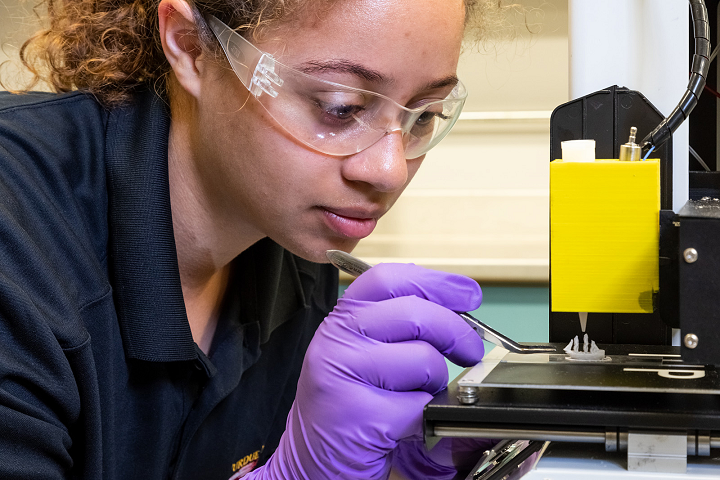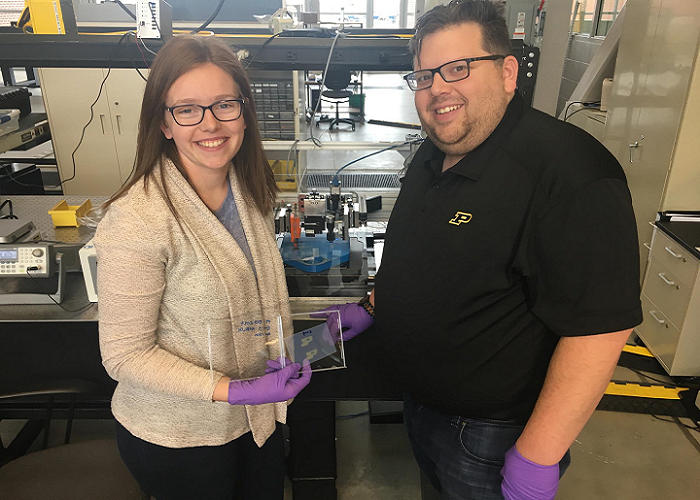Energetic materials are a class of material that contains high amounts of stored chemical energy that can be released, and they are used in everything from airbags to explosives. Last year, a team of researchers from Purdue University used 3D printed energetic materials to create a mini shock wave, and have since continued their work with these unique materials.
The researchers can safely 3D print energetic materials, featuring fine geometric features, for less money, at greater speeds. Now, Jeffrey Rhoads, a professor in the university’s School of Mechanical Engineering, has teamed up with several other colleagues, including former Purdue research assistant professor Emre Gunduz, to start a faculty-owned startup focused on making the energetic materials, like propellants, solid rocket fuels, and pyrotechnics, along with the 3D printers that can produce them.
Rhoads is now the COO of Next Offset Solutions, with Gunduz, now a professor at the Naval Postgraduate School in Monterey, California, as its CTO. The startup makes its energetic materials with a process – patented with help from the Purdue Office of Technology Commercialization – that allows the 3D printer to produce viscous materials, which have a clay-like consistency and can be difficult to extrude. The method makes it possible for the team to precisely, and safely, deposit the energetic materials.
Rhoads said, “It’s like the Play-Doh press of the 21st century.
“We have shown that we can print these energetic materials without voids, which is key. Voids are bad in energetic materials because they typically lead to inconsistent, sometimes catastrophic, burns.”
According to Rhoads, the startup’s 3D printer doesn’t use any solvents to lower the viscosity, which makes the process faster, more environmentally friendly, and less expensive. Additionally, the 3D printer is also much safer due to a remote control feature.
“You don’t have to have a person there interfacing with the system,” Rhoads explained. “That’s a big advantage from the safety standpoint.”

Monique McClain, a doctoral candidate in Purdue’s School of Aeronautics and Astronautics, demonstrates how it’s possible to 3D print extremely viscous materials.
The 3D printer functions a lot like more conventional 3D printers, with the exception of how it extrudes the highly viscous materials. High-amplitude ultrasonic vibrations are applied to the 3D printer’s nozzle, which lowers the friction on the nozzle walls and allows for more precise flow control of the material.
While Next Offset Solutions is mainly focused on producing energetic materials, it’s not adverse to further applications, other Purdue researchers have already used the startup’s novel method to 3D print things like personalized drugs and biomedical implants. For instance, because its 3D printing material has already been qualified by the departments of Defense and Energy, the startup hopes to provide its technology and products to the departments and their contractors.
 The startup is also focusing on additional advanced evaluation, research, development, and testing in the 3D printing and energetic materials space. But its original research definitely aligns with the university’s Giant Leaps celebration as part of its 150th anniversary, which celebrates Purdue’s “global advancements in health.”
The startup is also focusing on additional advanced evaluation, research, development, and testing in the 3D printing and energetic materials space. But its original research definitely aligns with the university’s Giant Leaps celebration as part of its 150th anniversary, which celebrates Purdue’s “global advancements in health.”
Purdue researchers have published several papers focusing on 3D printing energetic and viscous materials in the Additive Manufacturing journal, including:
- “3D printing of extremely viscous materials using ultrasonic vibrations“
- “Additive manufacturing of multifunctional reactive materials“
- “Selectively-deposited energetic materials: A feasibility study of the piezoelectric inkjet printing of nanothermites“
Take a look at the video below to see the viscous material 3D printing process for yourself:
What do you think? Discuss this work and other 3D printing topics at 3DPrintBoard.com or share your thoughts in the Facebook comments below.
[Source/Images: Purdue University]Subscribe to Our Email Newsletter
Stay up-to-date on all the latest news from the 3D printing industry and receive information and offers from third party vendors.
You May Also Like
Profiling a Construction 3D Printing Pioneer: US Army Corps of Engineers’ Megan Kreiger
The world of construction 3D printing is still so new that the true experts can probably be counted on two hands. Among them is Megan Kreiger, Portfolio Manager of Additive...
US Army Corps of Engineers Taps Lincoln Electric & Eaton for Largest 3D Printed US Civil Works Part
The Soo Locks sit on the US-Canadian border, enabling maritime travel between Lake Superior and Lake Huron, from which ships can reach the rest of the Great Lakes. Crafts carrying...
Construction 3D Printing CEO Reflects on Being Female in Construction
Natalie Wadley, CEO of ChangeMaker3D, could hear the words of her daughter sitting next to her resounding in her head. “Mum, MUM, you’ve won!” Wadley had just won the prestigious...
1Print to Commercialize 3D Printed Coastal Resilience Solutions
1Print, a company that specializes in deploying additive construction (AC) for infrastructure projects, has entered an agreement with the University of Miami (UM) to accelerate commercialization of the SEAHIVE shoreline...































